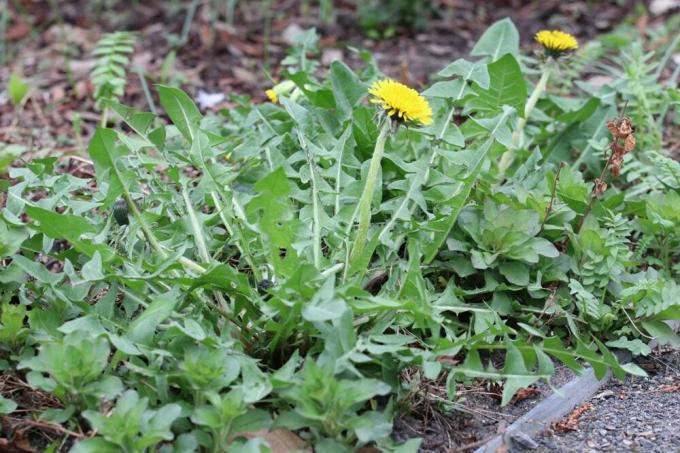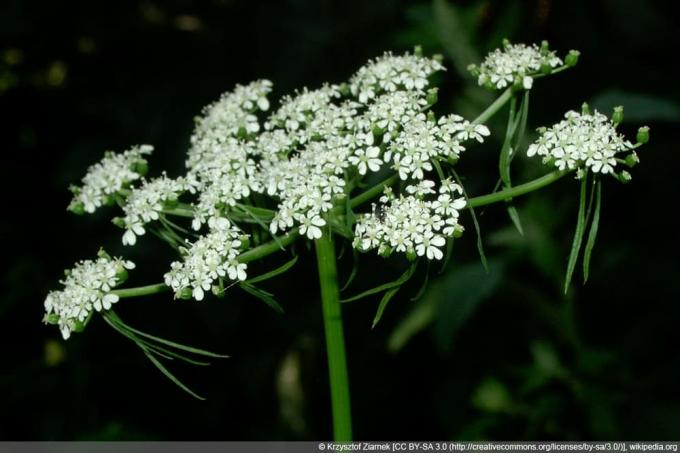
Table of contents
- Weeding made easy
- This keeps the garden weed-free in the long run
- Weed? Spice herb, medicinal herb, useful herb, salad herb, ornamental herb!
- Conclusion
Pulling weeds is really less of a rocket science, although there are weed witches who Urtica dioica (nettles) than use magic plants, and weeds suspected of magic, such as witch rings in the lawn (and there are magic weeds too, more on that below). However, how, where and when weeding does play a role:
Weeding made easy
If unwanted foreign growth spreads around you, it is worth a short "test weeding", one of each foreign plant, to find out how best to deal with the respective herb:
- First remove one of the foreign plants so that you have the root as completely as possible in your hand
- What can be removed easily and completely is rather uncomplicated to weed
- What is difficult to remove completely and leaves visible foothills in the ground should be determined
- Here every root has to be removed, if you don't have time, it's better to remove one plant first and mark the others
- In any case, after the trial weeding, you will know what the roots of the weeds look like
- And with that, which work tool could help you, because there are a few:
- The weed pen (also called "Schuffel") scrapes tender weeds out of the ground, whose roots do not go deep
- The roots of some weeds will then die off, but for others they should be removed, which is easy to do after a few days of drying
- The weeder tackles weeds with taproots
- But they can have foothills, which after a few days z. B. can be pulled with a weed tongs
- The garden disc simply cuts plants just above the ground, for some weeds the end after 2, 3 treatments
- The triangular Japan hoe, with its curved shape and sharp edges, also removes fairly deep roots
- A sow tooth also comes in the middle of a planting to deep-lying roots
- The best way to remove weeds from slab joints is with a joint scraper
- A kind of all-purpose weapon is the double hoe, with four tines on one side and a cutting blade on the other
- And the star tiller with a weeding blade, a kind of mini plow that gets rid of any vegetation on a strip of land (recommended only in exceptional cases, s. just below)
Also not unimportant when weeding is the time or the soil condition. Again, there is no one-size-fits-all formula, weeds “that hold their roots together” are best weeded when the ground is nice and soft after a heavy rain; if weeds can be eliminated by repeatedly cutting off the plant matter growing above the ground, this can work better if the soil is nice and hard and dry.
This keeps the garden weed-free in the long run
Weeds grow when the garden allows them to grow, and whether they do so is up to you. The “everyday weeds” that appear between the plants in the beds can be deterred if you simply do not give them room to develop. Plant a mixed crop that covers all or most of the soil, herbs between vegetables, or groundcover between ornamental flowers, or mulch bare soil. There is a famous tomato farmer who uses thick layers of straw to mulch between the tomato plants, which is great for the tomatoes. If a piece of ground is not to be planted in a season - it should be planted, because a bare and bare ground is sure to be rooted by anything, but not necessarily by that better.
However, there are plants that care for the soil, here are a few suggestions that go beyond the usual green manure and are useful:
- Sow an annual flower mixture, as it is sensitive to frost, only at the end of April or beginning of May
- Or a perennial herb mix that can be sown in spring or fall
- When sowing in autumn, you can avoid frost damage with loosely applied hay mulch (300 - 400 g/m²) or grass clippings (1 - 2 kg/m²).
- Flowers and herbs should be wildflowers and wild herbs, native plant species
- In the course of thousands of years of development, they have adapted to our environment
- They can cope with our weather and soil conditions, are competitive and provide food for wildlife
- Mix seed with filler (sand, sawdust, soybean meal), for loose sowing (10 – 20 g/m2 including filler)
- Important when buying seed: a detailed list of species is given, no cultivated plants, broad-growing grasses, clover, less than 50% grass
- Use seeds from Germany, preferably from your region (so-called autochthonous seeds)
- You get e.g. B. at Mellifera e. v, http://www.mellifera.de/blog/nbl-blog/wildpflanzen-regiosaatgut.html
- Or at Appels Wilde Samen GmbH, www.appelswilde.de, Rieger-Hofmann GmbH, www.rieger-hofmann.de, Natura-Saaten, www.natura-saaten.de
- If the meadow is to remain longer, it is mowed once or twice a year
- You can also plant potatoes and mulch the gaps well
- Or Hokkaido squash, or legumes, or corn, spread 3 to 5 cm of mulch on top, the seeded plants will grow through
If a piece of ground has not already been planted, was lying open and is now full of weeds, you can replace that land with a thick one Transform a layer of mulch back into a beautiful, bare garden soil, see article "Weeds extensively" for more information removed".
Weed? Spice herb, medicinal herb, useful herb, salad herb, ornamental herb!
Incidentally, it is also up to you whether weeds or aromatic herbs, medicinal herbs, salad herbs or ornamental herbs grow in your garden. Here are the talents of our most common “non” herbs:
- Field mint, Mentha arvensis, can be used like the related peppermint
- Field mustard, Sinapis arvensis, seeds can be used in a similar way to real mustard seeds, e.g. B. as a spice, also known as Bach flower mustard
- Bindweed, Convolvulus arvensis, pretty and pretty flowering, in suitable locations (if necessary. in bucket, spreads) very decorative
- Recurved amaranth, Amaranthus retroflexus, leaves like spinach, gluten-free seeds like rice and millet, roots like beets
- Sorrel, Rumex, e.g. B. delicious as sorrel in soups, just not too much and constantly because of the oxalic acid it contains (similar to rhubarb)
- Mugwort, Artemisia vulgaris, the most important spice in a good roast goose
- Broad plantain, Plantago major, young leaves as a salad, older leaves cooked in stews, contains calcium, other minerals and vitamin A
- Nettles, Urtica, food and dye plant, for fiber production, as butterfly pasture and plant strengthener
- Speedwell, Veronica, versatile perennial genus, in which valuable flowering perennials with many uses can be found
- Foxtail, Alopecurus, is said to prevent the development of allergies as a meadow foxtail, and is also cultivated as an ornamental plant
- Sowthistle, sonchus, is cooked as a vegetable sowthistle or eaten raw in a salad
- Daisies, Bellis perennis, flower buds, open flowers and leaves are edible, deliciously nutty to slightly sour
- White Goosefoot, Chenopodium album, food plant, fodder plant (also as birdseed), medicinal plant, green dye, mild soap substitute
- Giersch, Aegopodium podagraria, much better wild spinach than the limp green leaves from the store, helps against gout and more
-
 Günsel, Ajuga, z. B. some varieties of the creeping Günsel are planted as ornamental plants in parks and gardens
Günsel, Ajuga, z. B. some varieties of the creeping Günsel are planted as ornamental plants in parks and gardens - Ground ivy, Glechoma hederacea, became known as soldier's parsley because of its vitamin C content, spices and helps against some ailments
- Buttercup, Ranunculus, formerly used against rheumatism and nerve pain, but slightly poisonous when fresh, there are better alternatives today
- Shepherd's purse, Capsella, is currently used as a medicinal drug
- Dog's parsley, Aethusa cynapium, was once used as a medicinal herb, but beware: poisonous
- Corn poppy, Papaver rhoeas, edible plant, medicinal plant, ornamental plant
- Bedstraw, Galium aparine, food plant for insects, wild vegetables, edible flowers, "slimming herb" and anti-inflammatory, and much more. a.
- Buttonwort, Galinsoga, leaves tasty as a vegetable and salad, known as Guascas herb in the original homeland of Colombia
- Knotweed, Persicaria, is cultivated in many species and varieties as a culinary herb, medicinal herb and ornamental plant
- Spear thistle, Cirsium, leaves, young shoots and basket bottoms (as with the artichoke) of various species are eaten raw or cooked
- Ragwort, Senecio, caution, all types are poisonous, you don't necessarily need them in the garden, see article on Ragwort
- Field campion, Silene noctiflora, pretty little white carnation, which opens its flowers in the evening and is already endangered here
- Dandelion, Taraxacum sect. Ruderalia, leaves, flowers, buds, roots, as a spread, coffee substitute, jelly, caper substitute, salad, syrup
- Report, Atriplex, young leaves in salads and as spinach
- Black nightshade, Solanum nigrum, Caution: Poisonous nightshade plant
- Wheatgrass, elymus, root, runners for alcohol production and as a substitute for coffee, flour, salad, syrup, soup
- Tansy, Tanacetum vulgare, aromatic plant, used in herbal medicine, coloring plant
- Common rain cabbage, Lapsana communis, young leaves as a salad, spinach, herb
- Heron's Bill, Erodium, some species and varieties decorate gardens and parks as ground cover, in rock gardens or in crevices in walls
- Bluegrass, Poa, several species, especially meadow grass Poa pratensis, are important lawn, meadow and forage grasses
- Field horsetail, Equisetum arvense, is sold as bladder tea, blood cleansing tea, cough tea, kidney tea and rheumatoid tea
- Common yarrow, Achillea millefolium, leaves and shoots as a salad, care and medicinal plant
- Lesser celandine, Ranunculus ficaria, lettuce, quark spice, ornamental plant
- Ribwort plantain, Plantago lanceolata, see broadleaf plantain
- Cranesbill, geranium, flowers and leaves as a salad, medicinal plant
- Deadnettle, Lamium, young shoots as vegetables
- Common ragweed / ragweed, Ambrosia artemisiifolia, caution: invasive alien, allergy weed, s. Article Ambrosia
- Chickweed, Stellaria media, leaves as salad and tea
- White clover/creeping clover, Trifolium repens, flowers and leaves as salad, honey, jam
- Meadow clover/red clover, Trifolium pratense, see above
- Vetch, vicia, flowers and leaves as a salad
- Midsummer spurge, Euphorbia helioscopia, be careful, poisonous in all ways, you don't necessarily need it in the garden
Medicinal plants were only mentioned here (almost every herb helps against something, 87% of our currently used medicines work plant origins, but the application must always be under medical supervision anyway), and many herbs can still be used in completely different directions much more. If you take a good look at this list, the image of a round table could appear in the mind of a suspicious contemporary Representatives of listed corporations appear: food producers, pharmaceutical consultants, plant product manufacturers and owners of large nurseries, the grinning in an expensive restaurant on how to give consumers all the crops and medicinal plants that grow all by themselves as weeds sell. So that consumers can buy artificial “food” in the supermarket, consisting mainly of fat, starch and sugar, expensive pharmaceutical medicinal drugs (with ingredients of this weed) in the pharmacy and imported or cultivated, sensitive and pest-susceptible ornamental plants + pesticides in the garden center.
Conclusion
If you do without chemical destruction, which is time-consuming and potentially harmful in several respects, weeding is easy: dig up the soil, remove the plant, dig a hole in the ground. Keeping the garden weed-free permanently could be more labor intensive - at least until you turn your garden into a natural one You have brought balance to each other by keeping plants in check and you have gathered enough information that you can do something good for each herb can win.
 garden editorial
garden editorial I write about everything that interests me in my garden.
Learn more about weed control - weed control in the garden

Japanese knotweed: 11 remedies to combat it
Japanese knotweed allows areas to be greened quickly. However, the rapid growth makes the creeper a problem in nature. We've rounded up 11 ways to combat the invasive species.

remove dandelions | 7 Tips to Destroy, Get Rid of & Eliminate
The dandelion is a feast for the eyes only in fairy tales. In the garden, on the other hand, it turns out to be an annoying weed. You want one thing above all: get rid of him quickly. However, it is not that easy. How to fight him is here.

Recognizing dog parsley & avoiding confusion | Is she poisonous?
Parsley is one of the most important herbs in the kitchen and is often grown in the garden. In addition to the edible parsley, there is also a wild relative, the dog parsley. It looks confusingly similar to the edible version, but it is poisonous and can even be fatal in large quantities.

Hydrochloric acid against weeds, bamboo and ivy | Are acids allowed?
Weeds are annoying. Removing it is one of the most tedious and unpleasant jobs in the garden. Of course, one thinks about a radical solution to the problem. However, using hydrochloric acid against weeds is not a good idea and is not permitted.

Where are weed killers banned? That's what the law says...
Weed killers are practical - but not allowed everywhere. Where are they banned and what does the law say about them? We inform hobby gardeners about the most important rules for plant protection and legal, natural alternatives for weed killing in their own garden.

Removing Weeds: 9 Effective Sidewalk Remedies - Salt/Vinegar Info
Moss and weeds like to sprout in the joints of the paved garden paths. So the sidewalk, the driveway and also the terrace become an unkempt eye-catcher. But there are many effective ways to clean the paths and this does not necessarily require the chemical mace.
